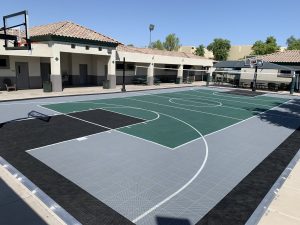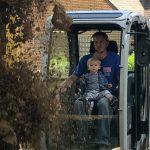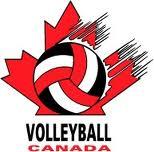
Across the United States, schools, recreation centers, athletic clubs, and private developers are rapidly adding racket sports to their facilities. These activities provide healthy recreation while serving as a reliable way to attract members, encourage community engagement, and generate additional revenue streams. While tennis has long been a staple in athletic programming, newer sports like pickleball and padel are quickly becoming popular additions.
For decision-makers—whether that’s an athletic director, a property manager, or a community planner—the challenge is deciding which type of court is the best fit. Each sport has its own requirements, from space and installation to ongoing maintenance. Player demographics and the potential for long-term growth will also influence your decision. This guide provides a clear comparison of padel, pickleball, and tennis, helping you determine which option makes the most sense for your facility.
Padel is a doubles-based sport that combines elements of both squash and tennis. Played on an enclosed court that is roughly one-third the size of a tennis court, padel uses a depressurized tennis ball and solid paddles. Because the ball can rebound off the walls, strategy and positioning are emphasized more than raw power, making the game accessible to beginners while still engaging for skilled athletes. The smaller court size and fast-paced rallies also make padel an attractive option for clubs looking to provide an exciting, social activity.
Pickleball has become one of the fastest-growing sports in the country. It is played on a compact court, similar in size to a badminton court, with a solid paddle and a lightweight, perforated ball. The rules are simple, and the smaller playing area makes it easier for beginners to pick up quickly. While it initially gained popularity among older adults for its low-impact nature, pickleball now appeals to families and younger generations who enjoy the sport’s fast learning curve and community-driven atmosphere.
Tennis is the most established of the three sports and requires the largest court. With singles and doubles formats, tennis emphasizes endurance, athleticism, and technical skill. It is deeply rooted in school and college athletics, country clubs, and community programs. While there is sometimes a steeper learning curve than with padel or pickleball, tennis offers a global reputation and remains a foundational sport for many institutions.
One of the most important factors when planning a new court is space. The dimensions and structural needs of each sport can influence where and how you build.
Padel courts measure about 66 feet long by 33 feet wide and must be fully enclosed with glass or mesh walls. The enclosure is integral to the game, as balls remain in play after hitting the sides or back wall. Because of these requirements, padel court installations are more specialized than other court projects. However, the compact footprint means facilities can fit multiple padel courts into the space required for a single tennis court, making it efficient for high-traffic clubs.
Pickleball requires the least amount of space, with courts measuring 44 by 20 feet. This makes them ideal for community centers, schools, or HOAs with limited outdoor or indoor real estate. In some cases, existing tennis courts can be converted into multiple pickleball courts, allowing facilities to maximize the use of existing infrastructure. Installation is typically straightforward, and depending on the site, construction can be completed relatively quickly.
Tennis, by comparison, requires the most land. A regulation tennis court is 78 feet long by 36 feet wide, with additional clearance needed around the edges for safe play. This means that a tennis court takes up significantly more space than padel or pickleball, and facilities must plan for fencing, seating, and surrounding walkways. Installation timelines vary depending on surface type—hard courts are faster to build, while clay or specialty surfaces require more extensive preparation.
Understanding who will use your courts is just as important as understanding the construction process. Each sport appeals to different demographics, and popularity trends can guide which option best fits your facility.
Globally, padel is one of the fastest-growing sports, with strong followings in Europe and Latin America. In the U.S., it is still emerging, which means facilities that invest early may gain a competitive advantage. Its social doubles-only format attracts young professionals, fitness enthusiasts, and club members seeking a fast-paced but accessible sport.
Pickleball has surged in popularity over the past decade, especially in the U.S. Based on participation data, it is most popular among adults over 50. However, interest is spreading rapidly to younger demographics, including families with children. For communities, churches, and HOAs, pickleball offers a way to engage multiple generations, making it a versatile addition to shared facilities.
Tennis is still widely recognized and respected, particularly within schools, colleges, and traditional athletic programs. Its global reach ensures long-term relevance, though growth in the U.S. is steadier than explosive. For institutions focused on established sports programming, tennis remains a safe and reliable option.
Court longevity and upkeep are essential considerations for any facility investment. While the installation cost may be significant, ongoing maintenance directly impacts long-term value.
Padel courts require routine inspection of the enclosure system and cleaning of glass or mesh walls. The surface itself has a lifespan similar to tennis courts and may need resurfacing over time, depending on use. Because padel is still new in the U.S., specialized maintenance services may be less common, which is vital to consider during planning.
Pickleball courts generally demand the least maintenance. Surfaces require periodic cleaning and line repainting, and outdoor courts may need seasonal care to address weather effects such as cracking or fading. This makes pickleball particularly appealing to community centers and HOAs that want a low-maintenance recreational option.
Tennis courts have varying maintenance needs depending on the chosen surface. Hard courts are the most durable but eventually require resurfacing every 5–10 years. Clay courts offer a traditional playing experience but require daily grooming and seasonal reconditioning. Grass courts, while rare, involve intensive upkeep and are generally reserved for high-end private clubs.
The right choice often depends on your audience, your available space, and the role you want the court to play within your facility’s programming.
Schools: Tennis remains a strong choice due to its long history in competitive athletics, but pickleball can provide a quick, accessible alternative for physical education and after-school programs. Its small footprint also allows schools to make use of multipurpose spaces.
Community Centers: Pickleball is an excellent option because of its broad appeal and low barrier to entry. Padel may also provide a unique draw, particularly in communities looking to expand recreational offerings.
Private Clubs: Padel can set a club apart from competitors by offering a sport not widely available in the region. Tennis remains a core amenity for clubs, but pickleball is increasingly being added to attract younger members.
HOAs: With limited space in many neighborhoods, pickleball’s compact court size makes it an ideal option. For communities aiming to stand out, padel may be considered, provided space and budget allow.
Churches: Pickleball’s accessibility and community-driven play style make it a natural fit for recreational programming. The sport accommodates all ages and skill levels.
Choosing between padel, pickleball, and tennis is ultimately about balancing space, cost, community interest, and long-term programming goals.
Pickleball offers a fast-growing, low-maintenance option with broad community appeal.
Padel provides a unique experience that is still gaining traction in the U.S. but could help facilities differentiate themselves.
Tennis remains a trusted choice with global recognition and deep roots in schools and clubs.
At Sport Court of Pittsburgh, we work with facilities across Western Pennsylvania to design and install custom solutions, including padel and multi-sport courts, tailored to your Pittsburgh property and audience. Whether you are planning for a school, community center, private club, or neighborhood, our team can help you evaluate options and create a plan that meets your goals.
Ready to take the next step? Contact Sport Court of Pittsburgh today to begin planning your facility’s next court project.

Owner & Founded of J Bird's Landscaping & Owner Sport Court of PA. 18+ Years of experience in Pittsburgh Sport court installation, lawn cutting, patio installation, trucking/hauling, French drain installation, and other landscape/design services.


